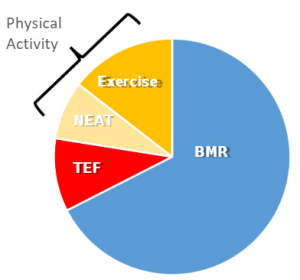Understanding Basic Concepts – BMR, TEF, TEPA & TDEE
Dr. Richa Bhatia
Basal Metabolic Rate (BMR) – BMR is the amount of energy a person needs to keep the body functioning at rest. BMR is influenced by factors like age, gender, weight, and muscle mass; and it accounts for about 70% of total daily calorie expenditure.
BMR varies between individuals; it can be as low as 1,000 kilocalories per day to as high as 2,500 kilocalories per day. Most effective way to raise your BMR is to increase your muscle mass.
The most notable formulae for BMR are Harris-Benedict Equation and Mifflin St Jeor equation. Online BMR Calculators can be used to calculate BMR.
Thermic Effect of Food (TEF) – is the energy expenditure associated with the digestion, absorption, and metabolism of food. TEF can vary depending on the macro-nutrient composition of your diet. Dietary fat is very easy to process and has very little thermic effect, while protein is hard to process and has a much larger thermic effect.
- Carbs/Fats: 5 to 15%
- Protein: 20 to 30%
A commonly used estimate of TEF is about 10% of one’s caloric intake.
Thermic Effect of Physical Activity (TEPA) – It has two components:
- Exercise Activity Thermogenesis (EAT) –refers to the calories burned during planned exercise activities, such as running, cycling, or weightlifting. EAT is a crucial component of total calorie expenditure and can be increased through regular physical activity.
- Non-Exercise Activity Thermogenesis (NEAT) –refers to the calories you burn through everyday activities that are not planned exercise (such as walking, cleaning, or fidgeting). NEAT can vary significantly between individuals and can contribute a significant amount to TDEE.
Total Daily Energy Expenditure (TDEE) – TDEE is the total number of calories your body burns in a day to maintain its current weight. It is influenced by several factors, including your BMR and Physical Activity Level.
TDEE = BMR (60%-75%) + TEF (10%) + EAT & NEAT (15%-30%)
You can simply multiply BMR by the Activity Factor to get your TDEE:
| Lifestyle | Activity Factor |
| Sedentary or light activity | 1.2 |
| Mild Activity | 1.3 |
| Active or Moderately active | 1.5 |
| Heavy/Labour Intensive | 1.7 |
| Extreme level | 1.8 |
Online TDEE calculators can estimate your TDEE based on your age, gender, weight, height, and activity level. These provide a good estimate; however, they are not 100% accurate since TDEE can vary based on body composition, genetics, and lifestyle. You can increase your TDEE by increasing your physical activity level, building more muscle mass, and eating a diet high in protein.

Components of TDEE
Calorie Deficit – If you are aiming to lose weight, you need to consume fewer calories than you burn. For example, if your TDEE is 2000 calories a day, but you consume only 1600, you’ll be in a 400 calorie deficit.
Aiming for 0.5-1kg weight loss per week appears to be the most sustainable goal.
To know more, please visit www.24bmi.com




